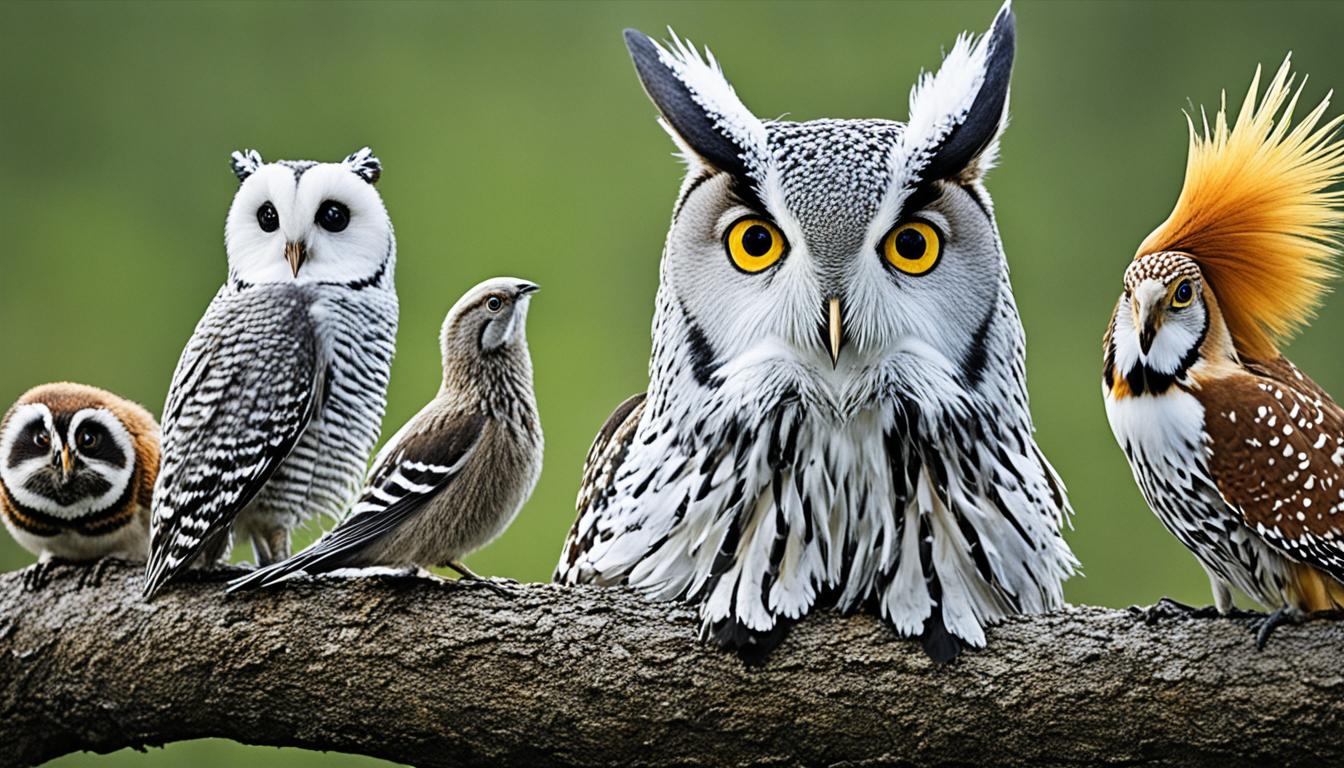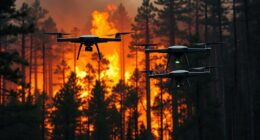Did you know that some animals have the ability to instill fear in even the bravest individuals? From venomous fangs to frightening appearances, these scary creatures roam the Earth, displaying the amazing diversity of the animal kingdom.
Get ready to encounter some of the most bone-chilling monstrosities that nature has to offer. Prepare yourself for close encounters with deadly spiders, haunting deep-sea dwellers, and unsettling reptiles. With toxic saliva, fang-teeth, and retractable jaws, you’ll wish you never have to come face to face with these terrifying creatures. Let’s explore the top scariest animals that will leave you awe-struck and perhaps a little bit unsettled.
Key Takeaways:
- These terrifying creatures showcase the incredible adaptations and survival strategies found in the natural world.
- From huntsman spiders to goblin sharks, these animals haunt our wildest nightmares.
- Their existence serves as a reminder of the awe-inspiring diversity of the animal kingdom.
- Prepare for close encounters with deadly spiders, haunting deep-sea dwellers, and unsettling reptiles.
- With toxic saliva, fang-teeth, and retractable jaws, these creatures are truly the stuff of nightmares.
Huntsman Spider
The giant huntsman spider is one of the most terrifying arachnids in the world. With a leg span of up to 12 inches, it is not only massive but also incredibly fast. This formidable hunter doesn’t rely on web weaving to catch its prey. Instead, it chases down its victims with its pincers bared, striking fear into the hearts of anything in its path.
Capable of killing anything from insects to possums, the huntsman spider is a true apex predator. Its lightning-fast speed and deadly venom make it a formidable opponent in the animal kingdom. Whether lurking in the corners of a dark room or scuttling across the forest floor, encountering a huntsman spider can be a hair-raising experience.
Take a look at this astonishing image of a huntsman spider:
It’s hard not to be both fascinated and a little disturbed by these eight-legged creatures. Their unique appearance and predatory tactics make them some of the most feared spiders in existence. Keep reading to learn more about other terrifying creatures that roam our planet.
Amblypygids
Deep within the mysterious realms of the rainforest, a remarkable creature known as the Amblypygid lurks. Also referred to as whip spiders or tailless whip scorpions, these arachnids possess a unique set of characteristics that set them apart from their spider counterparts. With their incredibly long and flexible legs that resemble antennae, amblypygids have fascinated scientists and nature enthusiasts alike.

The Adaptations of Amblypygids
One of the most intriguing features of amblypygids is their elongated legs, which can reach impressive lengths. These legs serve a dual purpose in their survival strategy. Firstly, they function as highly sensitive sensors, allowing the amblypygid to detect subtle vibrations and movements in its environment. This sensory ability aids in navigation, hunting, and recognizing potential threats.
Secondly, amblypygids use their elongated legs to capture and manipulate prey. While they might appear menacing, their diet mainly consists of small insects, spiders, and even other arachnids. They extend their legs forward in a whip-like motion to snatch their prey, darting with surprising speed and accuracy. However, it is essential to note that amblypygids are harmless to humans and pose no threat.
Whip Spiders: Rainforest Dwellers
Amblypygids are primarily found in tropical rainforests around the world. These secretive creatures prefer the dark and damp environments where they can scuttle across leaf litter, tree bark, and cave walls. They are nocturnal in nature, emerging from their hiding spots at night to hunt for food.
Whip spiders are a fascinating example of nature’s ingenuity and the extraordinary adaptations formed through evolution. Their unique anatomy and behavior showcase the incredible diversity found in the animal kingdom.
The rainforest serves as a perfect habitat for amblypygids due to its abundant prey and foliage cover. Their presence in these ecosystems contributes to the delicate balance and diversity of life
The Amazing World of Amblypygids
To further understand and appreciate the world of amblypygids, let’s take a closer look at their unique characteristics in the table below:
| Common Name | Amblypygids |
|---|---|
| Scientific Name | Order Amblypygi |
| Habitat | Tropical rainforests, caves |
| Leg Span | Varies by species, up to 12 inches |
| Prey | Insects, spiders, arachnids |
| Diet | Carnivorous |
| Behavior | Nocturnal, solitary |
Through the marvels of evolution, amblypygids have carved their niche in the intricate web of life. Their unique adaptations and fascinating behavior continue to captivate researchers and nature enthusiasts, reminding us of the incredible diversity that exists within the animal kingdom.
Deep-Sea Dragon Fish
The mysterious deep-sea dragonfish is an enigmatic creature that dwells in the depths of the ocean, lurking at a staggering 1,600 feet below the surface. With its mesmerizing appearance and unique adaptations, this fish has captured the fascination of marine biologists and deep-sea enthusiasts alike.
The deep-sea dragonfish, scientifically known as Idiacanthus antrostomus, possesses an intriguing feature that sets it apart from other deep-sea dwellers. Its fangs are composed of nanoscale-sized crystal particles, giving them an otherworldly appearance. These crystal fangs are not only aesthetically fascinating but also serve a crucial purpose in the fish’s predatory strategy.
Equipped with these nanoscale-sized crystal fangs, the deep-sea dragonfish relies on its exceptional senses to locate and capture prey in the pitch-black depths of the ocean. It has evolved a highly specialized sensory system that allows it to detect even the slightest movements in its dark environment. This sensory mechanism enables the dragonfish to strike swiftly and accurately, catching its unsuspecting prey with precision.
“The deep-sea dragonfish’s nanoscale-sized crystal fangs and its unique sensory system highlight the remarkable adaptations of marine life to survive in extreme environments,” says marine biologist Dr. Sarah Collins. “These features provide valuable insights into the evolutionary processes that shape the diversity of life on our planet.”
To further illustrate the incredible adaptations of the deep-sea dragonfish, consider the following key characteristics:
| Key Characteristics | Description |
|---|---|
| Nanoscale-Sized Crystal Fangs | The fangs of the deep-sea dragonfish are made up of nanoscale-sized crystal particles, giving them a unique appearance. |
| Sensory System | The dragonfish has evolved a specialized sensory system that enables it to detect movements in the deep shadows, allowing for precise strikes on unsuspecting prey. |
| Depth Habitat | The deep-sea dragonfish occupies depths of 1,600 feet in the ocean, where it navigates in near-total darkness. |
To catch a glimpse of the deep-sea dragonfish’s mesmerizing crystal fangs and its habitat, observe the image below:
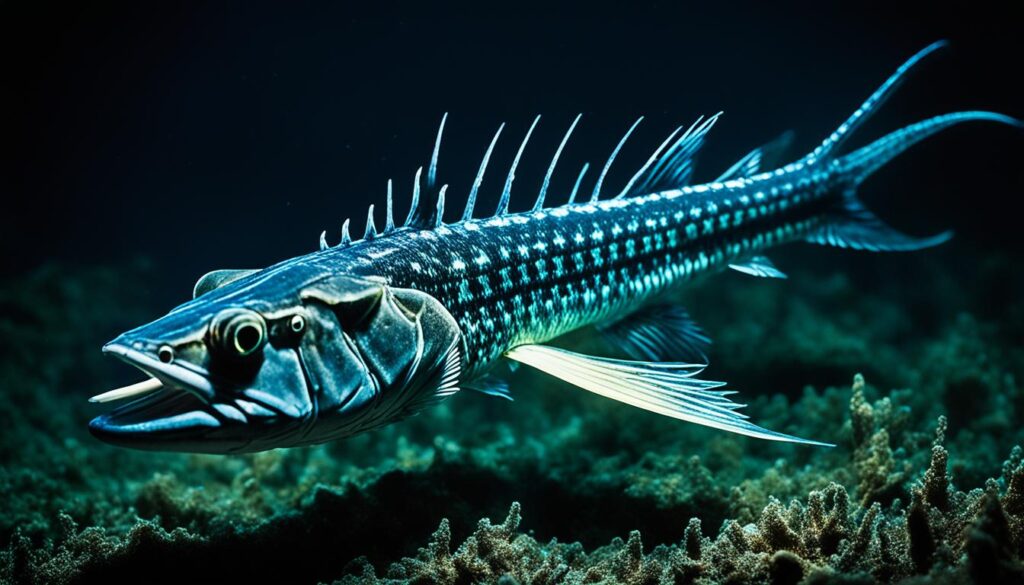
As researchers continue to explore the vast depths of the ocean, the deep-sea dragonfish remains a captivating and mysterious creature. Its nanoscale-sized crystal fangs and specialized sensory system serve as a testament to the astonishing adaptations that enable life to thrive in the most extreme and unforgiving environments on Earth.
Vampire Squid
Meet the mysterious vampire squid, a fascinating creature of the deep ocean. This unique cephalopod releases bioluminescent material as a defense mechanism against predators in the dark depths.
The vampire squid, with its scientific name Vampyroteuthis infernalis, is believed to be an ancient species that has been around for millions of years. It represents one of the only living descendants of the common ancestors of octopuses and squids.
This enigmatic creature possesses bioluminescent cells called photophores that cover its body. When threatened, the vampire squid ejects a glowing cloud of bioluminescent mucus, creating a dazzling display of light. This dazzling tactic helps confuse and disorient predators, allowing the vampire squid to escape or hide.
The vampire squid also has other unique adaptations that make it a truly fascinating creature. Its body is covered in a web of dark velvety skin, earning it the nickname “vampire squid from Hell.” The large fins surrounding its body resemble a cape, adding to its eerie appearance.

Found in the oxygen minimum zone of the deep ocean, the vampire squid resides at depths between 600 and 1,500 meters (1,970 and 4,920 feet). This is an environment characterized by low oxygen levels and high pressure, making it an extreme habitat.
The vampire squid survives in these challenging conditions by using a unique metabolic strategy known as “suspended animation.” It slows down its metabolic rate to conserve energy and can remain in a dormant state for long periods. This ability allows the vampire squid to survive in environments where food is scarce.
In addition to its bioluminescent defense mechanism, the vampire squid also has a fascinating feeding strategy. It uses long, retractable filaments to capture marine snow, a mixture of organic and inorganic particles that descend from upper ocean layers. This marine snow serves as a vital source of nutrition for the vampire squid.
Vampire Squid Facts
| Physical Characteristics | Habitat | Conservation Status |
|---|---|---|
| Dark velvety skin | Oxygen minimum zone of the deep ocean | Least Concern (IUCN) |
| Bioluminescent photophores | Depths between 600 and 1,500 meters | |
| Retractable filaments for feeding | ||
| Large fins resembling a cape |
California Condor
The California condor, known scientifically as Gymnogyps californianus, is the largest wild bird in North America. With a wingspan that can reach up to 9.5 feet, this magnificent creature commands attention wherever it soars. However, it is not just its size that makes the California condor remarkable; it is also a formidable scavenger that plays a crucial role in the ecosystem.
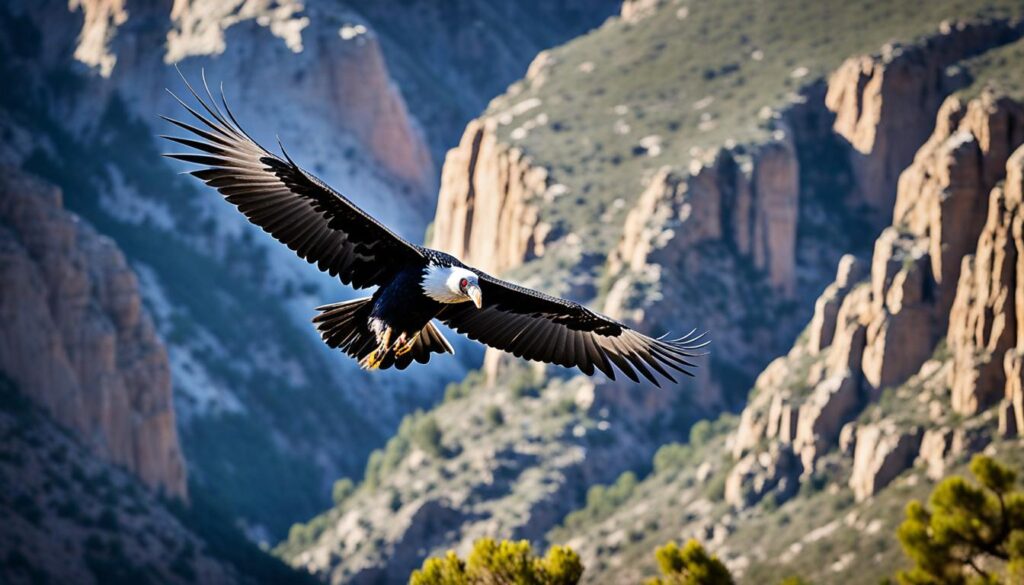
The California condor is predominantly a scavenger, feeding primarily on carrion. Its sharp beak is perfectly adapted for tearing into carcasses, allowing it to access the valuable nutrients within. By consuming carrion, the California condor helps to prevent the spread of disease by quickly disposing of rotting flesh.
These majestic birds were once on the brink of extinction, with only 27 individuals remaining in the wild by 1987. However, concerted conservation efforts, including captive breeding programs and habitat protection, have led to a remarkable recovery. Today, the California condor population has increased to over 400 individuals, making it one of the most successful conservation stories in history.
“The California condor’s resurgence is a testament to the power of conservation efforts and the importance of protecting our natural heritage.”
The revival of the California condor population is not only a cause for celebration but also a reminder of the vital role that scavengers play in maintaining the delicate balance of nature. These birds are nature’s ultimate recyclers, ensuring that no part of the cycle of life goes to waste.
Conservation Success
The recovery of the California condor population is a testament to the dedication and hard work of scientists, conservationists, and wildlife agencies. Through captive breeding programs and meticulous monitoring, these efforts have brought this magnificent bird back from the brink of extinction.
| Conservation Milestones | Year |
|---|---|
| Captive Breeding Program Established | 1987 |
| First Successful Captive Breeding | 1988 |
| First Reintroduction into the Wild | 1992 |
| Population Exceeds 100 Individuals | 2010 |
| Population Reaches 400 Individuals | 2020 |
Black Mamba Snake
The black mamba is one of the world’s deadliest snakes, known for its highly venomous bite. Found in Sub-Saharan Africa, this snake is a stealthy predator that strikes fear into the hearts of many. It possesses a powerful venom that can kill a human with just one bite, making it one of the deadliest snakes on the planet.
Black mambas are known for their incredible speed, agility, and aggressive nature. They can reach speeds of up to 12 miles per hour, making them the fastest land snakes in the world. When threatened, they can strike multiple times in rapid succession, delivering a potent venom that attacks the nervous system and can cause paralysis, respiratory failure, and eventually death if left untreated.

Characterized by its sleek body and jet-black coloration, black mambas are highly adaptable and can thrive in a variety of environments, from savannas to dense forests. They are excellent climbers and often inhabit trees, using their agility to ambush prey such as birds and small mammals.
Their reputation as highly venomous snakes has earned them the respect and fear of local communities. The black mamba’s notoriety is further fueled by its aggressive behavior when provoked. Despite its deadly reputation, however, black mambas generally avoid confrontation with humans and will only bite as a last resort when cornered or threatened.
| Fact | Information |
|---|---|
| Scientific Name | Dendroaspis polylepis |
| Length | Up to 14 feet |
| Habitat | Sub-Saharan Africa |
| Diet | Small mammals, birds, and occasionally reptiles |
| Conservation Status | Least Concern |
Despite the deadly reputation of the black mamba, it plays an important role in its ecosystem as an apex predator. Its presence helps to control rodent populations and maintain the balance of the food chain.
“The black mamba is a formidable creature, highly adapted to its environment. Its lethal venom and swift strikes make it one of the most dangerous snakes in the world.” – Dr. Sarah Johnson, Herpetologist
In conclusion, the black mamba snake is a fearsome predator and one of the deadliest snakes in the world. Its venomous bite and lightning-fast strikes make it a formidable force in its environment.
Giant Deep Sea Isopods
When it comes to the deep sea, there are some creatures that truly defy our imagination. One such example is the giant deep sea isopod. These incredible creatures are not only fascinating but also hold the title for being one of the largest crustaceans known to man.
Giant isopods are closely related to shrimp and crabs, but they dwarf them in size. With their elongated bodies and armored exoskeletons, they are powerful predators in the deep sea environment. But what sets them apart is their remarkable adaptation known as “deep-sea gigantism.”
In the dark depths of the ocean, where sunlight struggles to penetrate, conditions are drastically different from the shallower waters. The high pressures, lack of food, and cold temperatures have shaped the evolution of deep-sea creatures like giant isopods. As a result, they have grown to giant proportions, with some specimens measuring up to 16 inches in length.
These deep-sea giants inhabit the ocean floor, scavenging for food that falls from above. They have powerful jaws that allow them to crush the shells of dead animals and feast on the remains. Their slow metabolism and ability to survive long periods without food make them well-adapted to the challenging conditions of the deep sea.
While giant isopods may not be the most visually appealing creatures, they play a crucial role in the ecosystem of the deep sea. As scavengers, they help clean up the ocean floor, consuming the remains of larger animals and recycling nutrients back into the environment.
If you want to catch a glimpse of these fascinating creatures, you’ll need to dive into the depths of the ocean. But don’t worry, we have a closer look for you:

These giant isopods are a testament to the incredible diversity and adaptations found in deep-sea creatures. Their sheer size and unique characteristics make them a true marvel of nature.
| Giant Deep Sea Isopods | Fact |
|---|---|
| Scientific Name | Bathynomus giganteus |
| Size | Up to 16 inches in length |
| Habitat | The depths of the ocean floor |
| Diet | Scavengers, feeding on dead animals and organic matter |
| Special Adaptation | “Deep-sea gigantism” allowing them to grow to large sizes |
Goblin Shark
Goblin sharks are truly one of the most fascinating and terrifying creatures in the ocean. Known for their unique and distinctive features, these sharks possess jaws that protrude in an unnatural fashion, giving them a menacing appearance. Their ability to extend their jaws allows them to snatch prey with ease, making them highly effective hunters.
But what sets the goblin shark apart is its reproductive strategy. Among female goblin sharks, a phenomenon called oophagy takes place, where the unborn offspring are nourished by consuming unfertilized eggs within the mother’s body. This incredible adaptation ensures the survival of the unborn young, providing them with the necessary nutrients to develop and grow.
The goblin shark’s protruding jaws and intricate reproductive system make it a truly remarkable and fearsome predator. Its ability to adapt and thrive in its deep-sea habitat is a testament to the incredible diversity of life in our oceans.
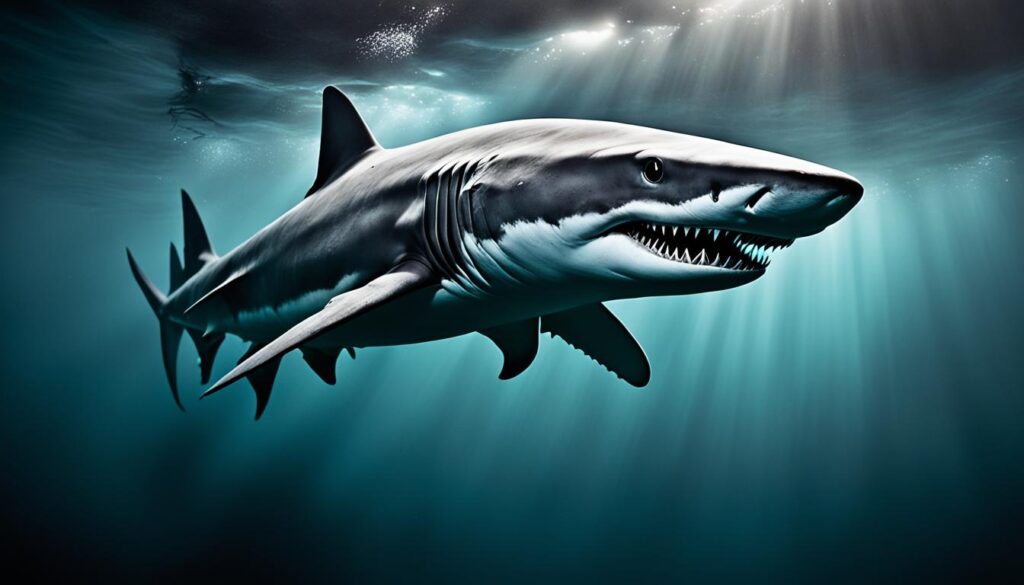
The image above showcases the unique appearance and striking features of the goblin shark, with its protruding jaws perfectly captured. This visual representation allows us to appreciate the intimidating nature of this incredible creature.
Conclusion
In conclusion, these terrifying creatures, from huntsman spiders to goblin sharks, showcase the diversity and awe-inspiring nature of the animal kingdom. While they may haunt our wildest nightmares, they also serve as a reminder of the incredible adaptations and survival strategies found in the natural world.
From the venomous black mamba snake to the giant deep-sea isopods, each creature has its unique features and abilities that allow it to thrive in its respective environment. The huntsman spider’s lightning-fast speed and lack of webs demonstrate its predatory prowess, while the California condor’s ability to scavenge for carrion showcases its role in maintaining the ecosystem.
Deep-sea dwellers like the vampire squid and goblin shark have evolved fascinating mechanisms to survive in the darkness of the ocean depths. The vampire squid’s bioluminescent ability confuses predators, while the goblin shark’s peculiar protruding jaws enable it to snatch prey from a distance. These adaptations highlight the intricate balance between adaptation and survival in extreme habitats.
By exploring these terrifying creatures, we gain a better understanding of the remarkable diversity and resilience present in nature. While they may evoke fear in our hearts, they also inspire awe and appreciation for the intricate web of life on our planet. The animal kingdom is a fascinating realm filled with lessons to learn and mysteries to uncover, reminding us of the incredible wonders that exist beyond our imagination.

